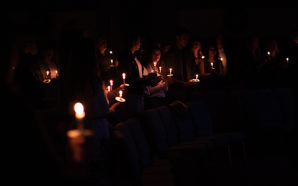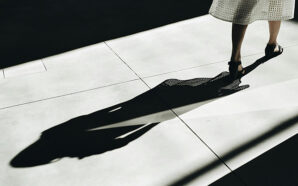First Sunday of Advent
Readings: Jeremiah 33:14–16; Psalm 24 (25):4–5, 8–9, 10, 14; 1 Thessalonians 3:12–4:2; Luke 21:25–28, 34–36
28 November 2021
“It is the Lord who speaks—when I am going to fulfil the promise I made” – Jeremiah 33:14
Advent remembers the fulfilment of God’s promise: that he would send a Messiah to save his people from sin and condemnation. Liturgically, the Church reminds us that this happens in two ways: the celebration of the Messiah’s birth—Jesus, at Christmas—and our spiritual preparation for his second coming at the end of time as the Christ—the Judge of the world—as today’s Gospel graphically reminds us.
The Gospel’s strong language is not meant to frighten or terrify us, but is God’s loving reminder to us—his beloved children, for whom he became flesh and died—that the ultimate purpose and goal of our life is not found in this earthly dwelling, but in the heavenly one: eternal life with God, who is Love. Thus, our holy Mother, the Church, reminds us through Advent to prepare our mind, heart and soul spiritually to be a worthy dwelling place for Our Lord to make his home at Christmas, but even more importantly to be ready through our Advent preparation for his second coming as our Judge at a time which we know not the day or the hour. For this reason, Jesus tells us today to “stay awake” (Lk 21:36), not from fear, but with Christian hope and trust that our faith gives us, so that we may “stand with confidence before the Son of Man” (Lk 21:36) when he does come.
In our current post-Christian era, which we can no longer pretend is not the case or be denied any more, true and faithful Christians are called more than ever before to be holy people who once again bear living and credible witness to the Lord who speaks through us and his Church: God has fulfilled his promise and dwells among us!
May Holy Mary, Virgin and Mother, through whom the Word was made Flesh and dwelt among us, walk with us this Advent, guiding us to Jesus, both in this world and the next. Amen.
Fr Christopher G Sarkis
Artwork Spotlight
The Martyrdom of Saint Andrew – Bartolome Esteban Murillo (1617–1682)
“The Martyrdom of Saint Andrew” (1675–1682). Oil on canvas, 123 × 162 cm. Museo del Prado, Madrid, Spain. Public Domain.
St Andrew, whose feast we celebrate on November the 30th, is virtually the first person we meet in Advent. His feast seems to be out of harmony with the season, and yet, when we think about it, his feast (like those of St Stephen, St John, and the Holy Innocents after Christmas), helps to put the Christmas mystery into perspective. When God the Son became flesh, he made himself vulnerable to physical, mental and emotional suffering. When Andrew accepted, without any conditions, Jesus’ invitation, “Follow me,” he, too, made himself vulnerable. In fact, like his Master, Andrew was headed for the cross.
Tradition tells us that Andrew suffered crucifixion during the reign of the Emperor Nero at Patras in Greece in A.D. 60. He was tied, instead of nailed, to a cross made like the letter X—since known as St Andrew’s Cross (it adorns the Union Jack). In this way, it was hoped to prolong his suffering. For two days he preached to the people from the cross before he died. His body was buried in Constantinople, but when the city fell in 1204, the Crusaders took his body to the famous fishing village of Amalfi in Southern Italy, and his head to Rome. It was one of the most treasured possessions of St Peter’s Basilica. Following the Second Vatican Council, Pope Paul VI returned the relic to Constantinople as a gesture towards unity with the Eastern Church.
The Martyrdom of Saint Andrew was painted by Bartolome Esteban Murillo (we will meet him again on Christmas Day) between the years 1675–1682, and hangs now in the Museo del Prado in Madrid. At one stage, it was acquired by Charles IV of Spain and displayed in the royal palace. It is a large canvas (50 x 66 inches), and seems to have been inspired by a painting of the same scene by Peter Paul Rubens.
The cross is surrounded by a great variety of figures who play different roles and express a range of emotions. Two men are attending to the fastening of St Andrew’s feet, while a third, crouching, looks over his shoulder at his companion—a black man. At their feet lie a ladder, an axe and a shovel. In the far distance, the populace mills about the nearby hill to witness the execution.
Murillo has balanced the foreground with two groups of figures. On the right are Roman soldiers—the commander and the standard bearer on horseback. On the left, two men converse—one pointing to the saint, and the other expressing anguish. Beside them are two women—one holding a small child and the other drying her tears with a cloth. The artist relieves the grimness of the tragedy with a touch of idealism, for over the martyr the heavens open— cherubs holding a crown and the palm of victory.
The feast day Mass gives one version of St Andrew’s call, but St John presents a much more revealing picture.
Andrew and another disciple hear John the Baptist refer to Jesus passing by as the “Lamb of God”. Interested, they follow Jesus some distance behind, perhaps too shy to approach him directly. Then Jesus did something entirely characteristic. He turned and spoke to them, that is, he met them halfway. It was an example of the divine initiative. It is always God who takes the first step. St Augustine said that we could not even have begun to seek for God unless he had already found us. Jesus asked the two disciples: “What are you looking for?” A good question for us to face as we enter this season.
Before the multiplication of the loaves and fishes, it was Andrew who introduced the little boy with the five barley loaves and two fish to our Lord. And when some Greeks asked St Phillip for permission to speak with Jesus, Phillip referred them to Andrew. These events are alluded to in the Collect of today’s Mass: “May St Andrew be for us a constant intercessor before you.” Andrew, we ask you to introduce us to Jesus.
Mgr Graham Schmitzer
Fr Christopher G Sarkis is the parish priest at Our Lady Help of Christians Parish in Rosemeadow, NSW. He was ordained in 1985 and has served in a number of parishes in the diocese. His recent diocesan appointments include member of the College of Consultors, Council of Priests, Diocesan Finance Council and Diocesan Property Committee.
Monsignor Graham Schmitzer recently retired as the parish priest at Immaculate Conception Parish in Unanderra, NSW. He was ordained in 1969 and has served in many parishes in the Diocese of Wollongong. He was also chancellor and secretary to Bishop William Murray for 13 years. He grew up in Port Macquarie and was educated by the Sisters of St Joseph of Lochinvar. For two years he worked for the Department of Attorney General and Justice before entering St Columba’s College, Springwood, in 1962. Fr Graham loves travelling and has visited many of the major art galleries in Europe.
With thanks to the Diocese of Wollongong who have supplied the weekly Advent and Christmas 2021 reflections from their publication, Blessed – Advent & Christmas Daily Reflections 2021.








